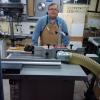I'm just about ready to buy a European combo machine (A Minimax C30G, to be precise) to replace my low-end, but perfectly servicable hybrid table saw, standalone jointer and Dewalt 635 planer. All good - I've pretty much convinced myself to live with combo planer-jointer limitations. The thing that's holding me up is that I have a cast iron router table with quality lift and a good router spindle, and a wide collection of bit profiles that I use a lot in my woodworking. It's attached to the table saw, and I really don't have room for it as a standalone machine in the shop, if I go ahead with the Minimax. So my go to machine for most router work will have to be the shaper on the Minimax (I can do some things with my horizontal router table/mortiser, but not most things).
Anyone have experience with going from a very solid router table setup to a combo machine shaper, and the resulting bit profile poverty and change in capabilities? Regrets?





 Reply With Quote
Reply With Quote






